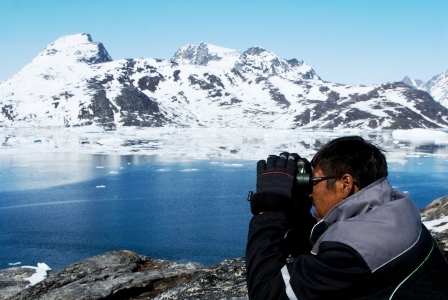
Photo by Elmer Topp-Jørgensen
The information contained in this database was collected through the collaboration of citizens along the western and northern coasts of Greenland. The goal of this collaboration is to document status and changes of local natural resources, inform decision making for natural resource management, and preserve and pass on local and traditional knowledge of natural resources and resource use. Arctic communities have long recognized that natural resource conditions are not what they once were. Some species are disappearing. Some species are coming back after having been away for a long time; and some species are turning up in larger numbers than before. The status of the living natural resources has very direct impact on the incomes and lives of people. While such changes have been recorded in detail in the oral history, this knowledge has not been used to inform natural resource management decisions at national and policy maker level. This database serve as a tool for securing the documentation and use of the local and traditional knowledge of the people in the communities of Greenland. It serves as an archive and instruction tool for the collaborating fishermen, hunters and their communities. It is designed to be flexible enough to change in response to the evolving nature of the observations while providing a framework that allows community members and researchers to track and compare specific ecological, environmental and climatic features and events across geographic locations and over time.
Through quarterly (three-monthly) reports of natural resource conditions and explanations of local trends in resources and possible management interventions, observers assist the local authority and the central government in better understanding natural resource processes and interactions. This information is leading to better-informed government decisions on natural resource management. A wide range of management actions have been proposed of which some have been implemented, while others were declined or are still awaiting approval. The management actions proposed based on the local natural resource observer program have been locally different in nature. However, they all are directly related to utilization of specific resources or areas and are connected with how the resources and landscapes are being managed. The management proposals include amongst others: regulation of fishing in certain areas, changes in harvesting procedures, regulation of quotas and sustainable harvest, changes in hunting and fishing seasons, proposals on changes in fishing and hunting regulations, changes in access and means of transportation in certain areas, and development of new resource enterprises and ways of utilizing resources. Additionally, the database and interactive website are publicly accessible tools available to community members, educators, outside researchers and policy makers.
The local natural resource observer program was borne out of a long partnership between local Greenlandic natural resource experts and their communities, government staff and scientific researchers, originally through the Piniakkanik Sumiiffinni Nalunaarsuineq (PISUNA) project.